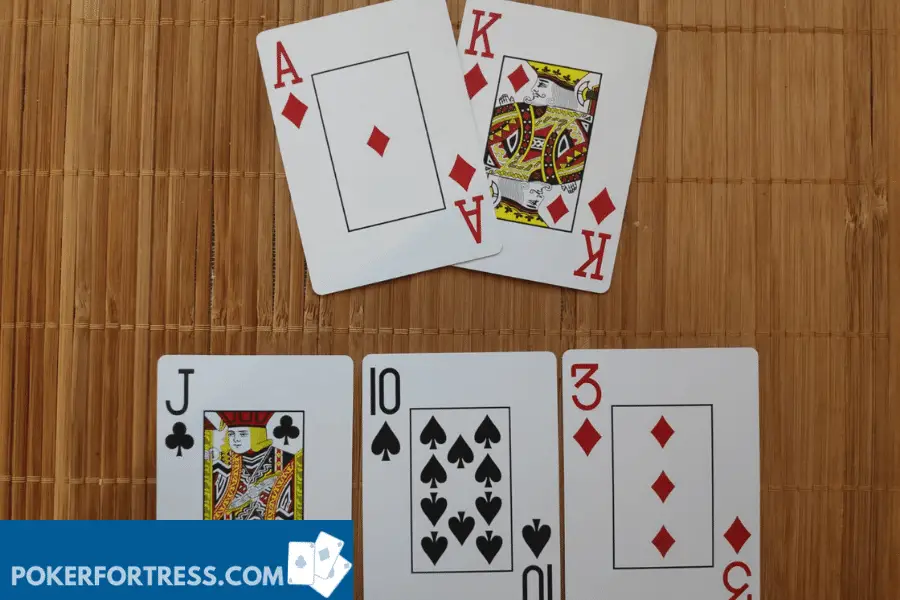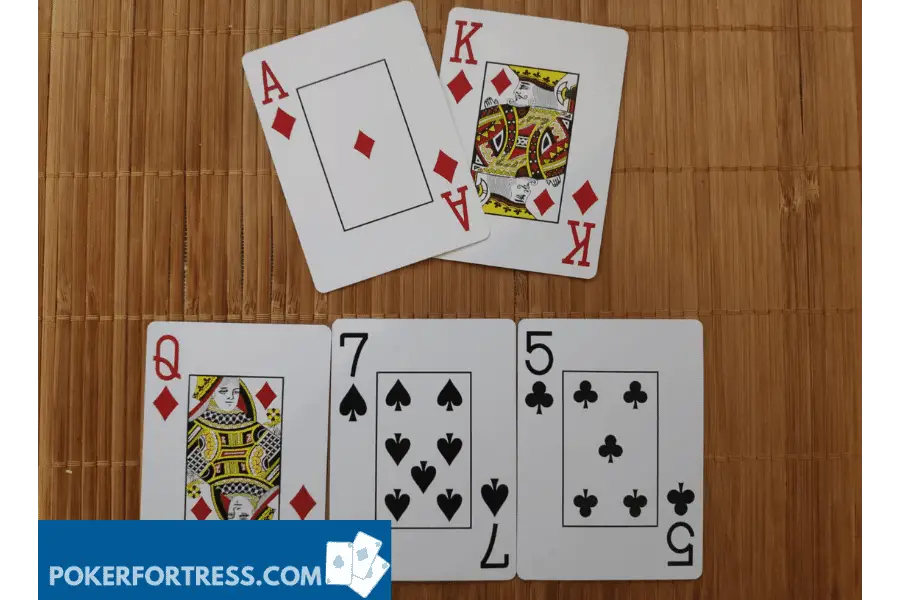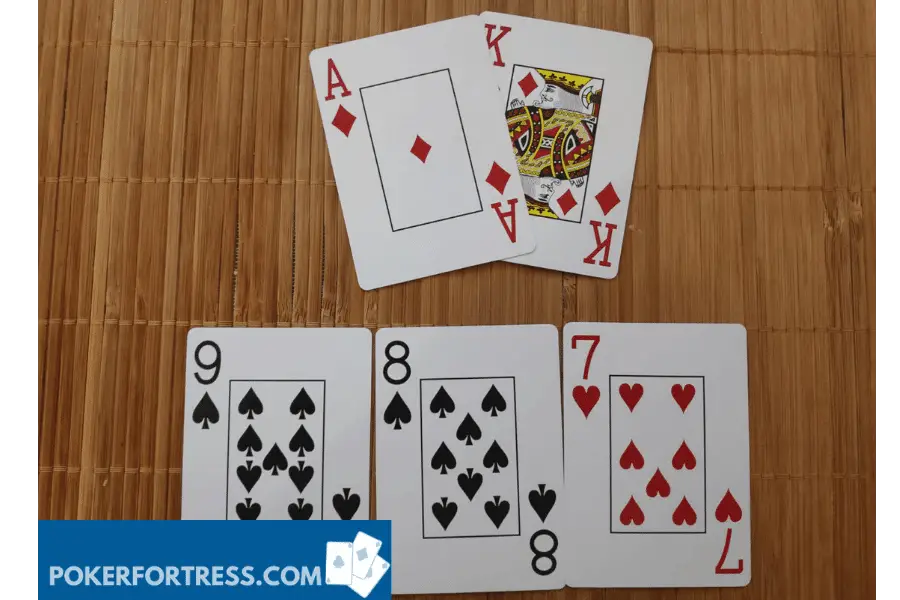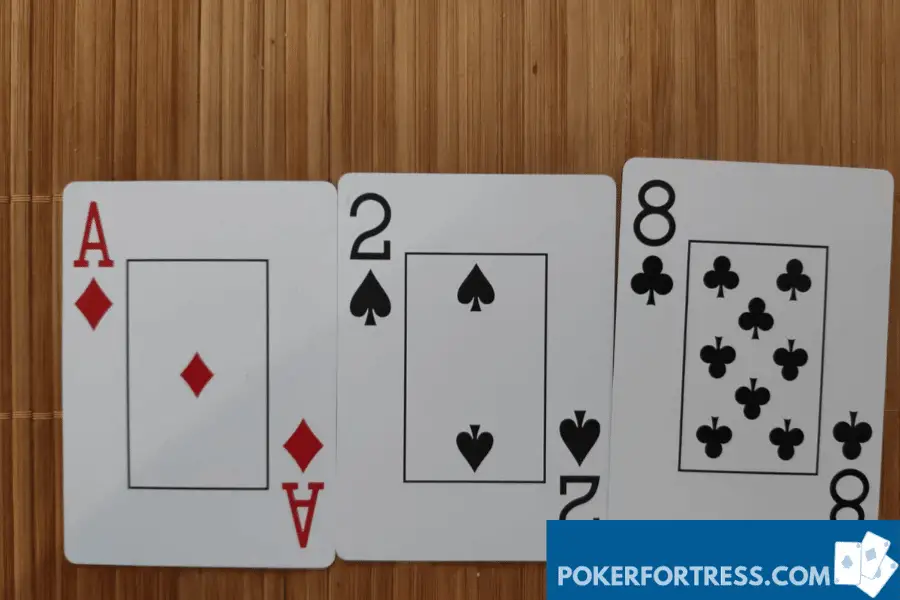
A missed flop happens two-thirds of the time. It’s not uncommon, even with Ace-King suited. So before you hit the felt, be sure that you have a solid plan on how you can work around it. Missed flops are easy to deal with; some pros would only fold on it, but if you keep missing every flop, everything changes.
So, what do you do if you keep missing every flop? It’s still possible to make a lot of money even if you miss the flop, but it would depend on your position and your opponents’ range.
Ace-high boards, for example, are great if you want to bluff and apply proper aggression. However, being successful when playing missed flop requires more than just placing bets!
If you miss the flops consecutively, the first thing that you should do is figure out whether that flop puts you in a position to play aggressive or not.
Remember that aggression is what you need, to win the pot, but it’s not always that you need to build it.
Three Types of Missed Flop
The easiest way for you to keep playing missed flops is to familiarize yourself with the different kinds of missed flops. Once you’ve made yourself aware of these types, you can move forward on deciding the appropriate course of action.
Missed flops or not, it doesn’t matter. The level of ambiguity in poker makes it possible for anyone to play their hands strategically, and still come out on top. You only need to be adaptive when tackling different types of flops because it carries different levels of risks.
Bring It On Flop
Missed flops aren’t always that bad. Sometimes, there are the ones that I call the “bring it on flop.” It comes with high-value cards or a combination of cards that still keep you in play.

An excellent example of this is when you’re holding A-Diamonds and K-Diamonds, while the flop is J-Clubs, 10-Spades, and 3-Diamonds.
It’s a missed flop, but it keeps your hand in play with the potential to give you a backdoor flush draw or a gutshot straight draw. It also has massive potential for two overcards that can make a strong top pair.
Betting on bring it on flop can be quite tricky. Most players would play aggressively with this hand, but a check is an ideal move for this situation.
When working with this hand, you should never overvalue its potential. It’ll be a very tough spot if you make your bet, then another player raises. Given that you’ve missed the flop, it would be challenging to walk away with all the possible draws that this flop can create.
A check will keep you in a comfortable spot. In case your opponent makes a bet, you’ll be able to put it in range, giving you more data to work on when evaluating the table. The bring it on flop gives you an acceptable hand that is strong enough to see the turn, and a check will allow you to do it without taking too much risk.
So-So Flop
So-so flop is a combination of cards that offer backdoors, but not much to work on other pairs on the turn.
So-so flop is the type of flop where we start veering into the bluff and aggressive playstyle territory.
An excellent example of a so-so flop is when you’re holding A-Diamonds and K-Diamonds, while the flop is Q-Diamonds, 7-Spades, and 5-Clubs.

It’s a missed flop, but it still gives you two overcards for a strong top pair and a backdoor flush draw. Other than that, there’s not much that you can work on the turn. In a lot of cases, an opponent who makes a raise with this flop in play has a made hand, and you’ll, most likely, only be drawing dead.
There is a slight possibility for backdoor draws or overcard outs. It’s not a good hand, but it’s strong enough for you to bluff. Playing with this hand would always lean towards aggressive playstyle, and if your opponent raises, it’ll be a lot easier to find a fold.
You’re Dead Flop
You’re dead flop is pretty self-explanatory. There’s nothing that you can do with this hand, and you’ll always draw dead. This missed flop is the absolute worst-case scenario, and some poker pros would only fold on it, then move on to another hand.
An excellent example of you’re dead flop is when you’re holding A-Diamonds and K-Diamonds, while the flop is 9-Spades, 8-Spades, and 7-Hearts.
There are all kinds of strong draws and made hands possible with this flop. Add it to the fact that it smashes most preflop caller’s ranges. With this flop in play, there’s not much that you can do, aside from a check or fold.

Folding is the safest course of action, but applied aggression can, hopefully, get another player to fold. You only need to keep track of your opponent’s range, though, because bluffing with a made hand in this flop is drawing dead, and you may not even notice it.
Bluffing on Missed Flops
Bluffing is a typical course of action for missed flops, but it’s not always a good idea.There are missed flops that are great for bluffing, while others have too many possible draws that bluffing doesn’t even make sense.
When you keep missing every flop, it’ll be easier to identify flops that are good to bluff versus the ones where you’ll only be drawing dead. There are fewer factors to consider and fewer courses of action to take. It’ll be easier for you to ask yourself, is it a good time to bluff or not?
Best Flops to Bluff
When working with a very dry flop and if you’re in position, it’s best to play aggressive and bluff. The best example for it is when the flop has Ace-high with two low disconnected cards, like A-Diamonds, 2-Spades, and 8-Clubs.

Let’s say that this is the flop, or something similar to this setup, and I’m on the button. Regardless of my hand, my cbet will always be half pot, and I’ll be betting almost every time. There are times when I’d go as low as 33%, making it easier to fold when I get called.
Even if I keep missing the flop, betting small and long term on these missed flops will make me lose less than just giving up on multiple hands. Dry flops are easy to spot, and exploiting it will make my stacks last longer than folding every time I miss the flop.
Bad Flops to Bluff
When a flop has several possible draws, it would be better to fold and wait for another hand. Even when playing heads up, an opponent will, less likely, fold enough that I’ll come out ahead in stacks, long term.
Flops with possibilities for an open-ended flush draw or straight draw is not an ideal time to be the aggressor. The more chances there are for a backdoor draws or made hand, the less likely you’ll make a profit from those missed flops if you try to bluff.
If you want to come out on top, especially when playing against three or more players, it’s best to stay away from betting in a multiway. Betting on a flop where players are less likely to fold will make it harder for you to make profitable bets if you keep missing the flops.
Move Based on Opponent
If you have sufficient hand data, using simple math can work to your advantage in coming out on top. Even if you keep missing the flop, you’ll still win more than half of the time if you know how to play against different types of players.
A lot of poker pros use HUD to understand other player’s play style, and it becomes a lot simpler to make profitable plays.
When playing on low limits, the majority of players will fall in either of these two categories; overly aggressive players and passive players who fold too often.
Aggressive Players
It’s funny to think about it, but some players can’t seem to fold on anything and players who check-raise too often. You can see a lot of players who bet too much when playing microstakes, and these players are less likely to fold, regardless of their odds of winning. Even if they’re holding a low-value pair or a backdoor draw, it’s enough for them to justify a call.
There’s not much that you can do when playing against aggressive players. You can’t bluff them, because of their small regard for the stakes. Your best bet when playing against these players is to take a free card and hope that you hit something decent on the turn.
When playing against aggressive players, you should never inflate the pot. Instead, it would be best to keep placing marginal bets. Higher stakes give an aggressor more reason to call, raise, or reraise, and you don’t want that when trying to apply strategic aggression.
Instead of thinking how to work around missed flops against aggressive players, it would be wiser to wait for a made hand, then bet. These players will always keep showing aggression on the turn and river, regardless of what they have. So calling them when you have better cards, gives you higher chances of picking up a massive pot.
Passive Players
Microstakes is where you’ll find all kinds of extreme players, and it’s a nesting ground for passive players. These players will always fold every time they miss the flop, and that’ll be more than 50% of the time.
As mentioned earlier, missed flops happen two-thirds of the time, but you can use this to your advantage. There won’t be a lot of massive wins when playing against passive players, but if you play small and long term, you’ll eventually come out on top.
When playing against extremely passive players, make a cbet equal to half of the pot. If a player folds more than 50% of the time, you’ll come out ahead.
It doesn’t matter if your opponents get occasional strong hands, because your bets will always be the same.
If you keep betting five chips against a passive player, you’ll win ten chips more often than you lose five chips. This technique is one of the best ways to turn missed flops into easy profits, especially when playing microstakes.
As long as they don’t adapt to your strategy, which is less likely to happen in a low stakes game, these players will be your excellent customers and a reliable source of small, consistent profits.
Practice Proper Aggression
When betting on a missed flop, the end goal is to force your opponents to fold. However, it doesn’t mean that being aggressive will always result in profitable hands. If you’re betting with no equity and no blockers, you’ll most likely, end up getting more losses than wins.
It would be best to have a strategy for every scenario when you miss the flop. You’ll only hit a pocket pair or better, one-third of the time. So it’s vital to devise a plan other than just picking up the pot or check, then hope that you’ll get a free turn card.
Executing proper aggression on different streets and plays is key to winning.
This part of the game is where off-table work pays off. When playing No-Limit Hold ’em, for example, a player who has better knowledge in maneuvering and manipulating a table has a better chance of winning the long game. Don’t bet or fold on a missed flop without a solid reason, because each decision, big or small, will affect the outcome of the game.
Relative Positions
Positioning can make it easier or harder to apply pressure when trying to bluff on a missed flop. If you have the position, it’s easier to place bets and make your opponents feel pressured that they end up folding a better hand.
Being the last to act also gives you the freedom to take the free card if you want, and reduce the risk that you take. If you have a weak card, it’ll be easier to play your cards and apply proper aggression, if every player has already made their moves.
If you’re playing against two or more players, missed flop barely matters. Letting them make their move, then evaluating your hand based on how they placed their bets will make it simpler to place profitable bets.
Playing in position is where you start thinking in terms of ranges and not the hand. For example, raising preflop in early position will represent a wide range of high-value cards, including high pairs and ace-high hand. By doing this, you’ll be in a better spot to be aggressive, even if you missed the flop.
Out of position, on the other hand, limits your flexibility to bluff, and you need to be more selective of the flops that you can takedown. In a lot of cases, it would be better to fold complete air, rather than make a cbet on flops that isn’t ideal for your range.
So when you keep missing the flop, and you intend to bluff, you’ll be better off taking cheap, little potshots. Sometimes, the most unprofitable calls that you’ll make will happen when you’re out of position.
The important thing is that you create a plan, possibly preflop. Do you want to run a multi-street double barrel or a triple barrel going out?
You’ll want to consider all of these possible scenarios, even before you miss the flop because this will help you represent a range.
Giving Up is Fine
There’s nothing wrong with giving up, and sometimes, it’s a lot better than forcing your way through missed flops. Sure, there are some strategies that you can use if you keep missing the flop, but the safest path is to fold and wait for a better hand.
Poker is known for a great deal of ambiguity. It’s a game where accumulated small correct decisions are much better than a handful of big wins. Don’t get frustrated, even if you keep missing the flop. If you’re unsure of what you can do, and how you can use a missed flop to your advantage, it would be best to fold and protect your stacks. Play the long game, and focus on making the correct small decision every time.
Conclusion
Missed flop doesn’t always mean a missed opportunity to win. Poker pros know how to use it to their advantage. Careful evaluation of the table will get you ahead, especially when playing the long game. Knowing how your opponents play, and their personality as a player will also help you make the right decisions.
Low or high stakes, it doesn’t matter. You can use your aggression to win slowly but surely, but a careful and strategic opponent can also use it to their advantage. Adaptability and learning how your opponents play will help you make the right decisions and use missed flops to your advantage.



